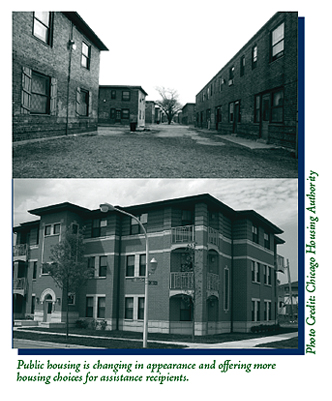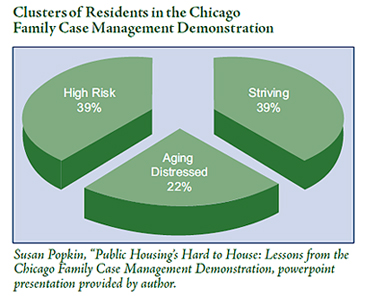December/January 2010
In this Issue
New Approach To Serving Vulnerable Families
Foreclosure Risk Lowered With Downpayment Assistance
Stabilizing Communities With NSP Dollars
Models of Sustainable Affordable Housing
In the next issue of ResearchWorks
New Approach To Serving
Vulnerable Families
Public housing is changing in appearance as aging, distressed, crowded, and unsafe conditions give way to mixed-income developments and more housing choices for recipients of housing assistance. At a congressional committee hearing on the future of public housing, Urban Institute researcher Susan Popkin testified that many former public housing residents now live in better, safer housing. She noted, however, that the challenge remains of helping "the most vulnerable families — those 'hard to house' families with multiple, complex problems that make them ineligible for mixed-income housing or unable to cope with the challenges of negotiating the private market with a Housing Choice Voucher."1
 The Chicago Housing Authority (CHA) is stepping
up to meet this challenge by testing a new model
designed for serving such hard to house families: the
Chicago Family Case Management Demonstration.2
At the heart of CHA's innovative service model is a
form of case management that is both intensive and
comprehensive, customized to help families establish
safe, stable housing. The underlying premise is that
these families can build on their inherent strengths
and capacities while an engaged case manager works
with them to overcome difficult circumstances,
thereby building motivation and support. The new
model features several key differences from the usual
service delivery model:
The Chicago Housing Authority (CHA) is stepping
up to meet this challenge by testing a new model
designed for serving such hard to house families: the
Chicago Family Case Management Demonstration.2
At the heart of CHA's innovative service model is a
form of case management that is both intensive and
comprehensive, customized to help families establish
safe, stable housing. The underlying premise is that
these families can build on their inherent strengths
and capacities while an engaged case manager works
with them to overcome difficult circumstances,
thereby building motivation and support. The new
model features several key differences from the usual
service delivery model:
- Family caseload management replaces a focus on individual heads of household. Family is understood to include relatives, close friends, and significant others.
- Caseloads are smaller (25, not 55), thus allowing case managers to visit families in their own homes and make weekly (rather than monthly) visits.
- Case managers remain engaged with a family, even after a relocation, for at least three years, rather than as little as three months.
- Case managers have the support of a clinical case supervisor in adjusting to the new model and developing needed skills.
- Supplemental services in the form of a transitional jobs program, a financial literacy program, and a matched savings plan help strengthen residents’ life skills.
- Enhanced relocation counseling assists residents in understanding their housing options, selecting an alternative housing unit, and negotiating their move, with follow-up afterwards.
- Agencies involved in service delivery and program evaluation closely coordinate their efforts.
CHA is testing this model with 475 hard to house families who were living in two of the city’s largest public housing developments, Wells/Madden and Dearborn, in March 2007. At the time, Wells/Madden was about to be closed, with many families having already left the sadly deteriorated units. More than 200 families still resided in Dearborn, whose buildings were being either renovated or demolished. These households had arrived at a decision point brought about by external circumstances: Would they continue to live in traditional public housing, turn to the private market with vouchers in hand, or move to new, mixed-income developments?
A baseline survey of the heads of these 475 households indicated that more than half had children under the age of 18 and 12 percent were over the age of 62. The median length of tenure in CHA housing was 28 years. Seventy percent had an annual household income of less than $10,000; 31 percent had paying jobs, 47 percent received some type of public assistance, and 71 percent qualified for food stamps. Four out of every 10 did not have a high school diploma. More than half of the residents described their health as fair or poor, reporting diagnoses of obesity, hypertension, asthma, depression, and anxiety.
Researchers are monitoring the outcomes of this demonstration to see if and to what extent these families will be able to improve their housing opportunities. They found that after the first year:
- Resident/case manager engagement improved markedly compared with a year earlier. The engagement rate in Wells/Madden rose from 43 to 79 percent; in Dearborn, it rose from 56 to 80 percent.
- Of 75 households referred for relocation counseling during the first year, 63 moved to private market units using Housing Choice Voucher program assistance and 12 moved to other public housing units. The neighborhood poverty rate improved for 13 families, and one moved to a neighborhood that seemed to offer significant opportunity.
- 5 clients participated in a Transitional Jobs program and 15 became employed.
- 21 households enrolled in a Get Paid To Save
program, and two-thirds were able to save regularly.

The first year's experience with the model pointed to several emergent lessons. Additional support for case managers was necessary because of the intensive needs of hard to house families. Communication and coordination among the multiple agencies that delivered services were seen as critical. The employment and literacy programs needed a closer fit to the needs of clients experiencing significant barriers to education and employment. Finally, many clients were unready to move, despite the relocation services and workshops available.
Researchers continue to monitor outcomes and progress, remaining alert to whatever program adjustments and solutions are needed to overcome the multiple barriers faced by this extremely vulnerable population. The program has already produced a valuable tool that offers the needed means and methods to effectively target resources and services — a resident typology. This typology recognizes three target groups (striving, aging and distressed, and high risk), each with unique characteristics that point to particular service needs.
Now in its third year, the demonstration program is being thoroughly evaluated, and results will be available in 2010. According to Popkin, the evaluation will include an analysis of administrative data, results from baseline and follow-up resident surveys, a comparison with residents in other CHA developments, an analysis of cost-effectiveness, and a determination of the best way to serve each of the identified resident types.
1 Susan J. Popkin, testimony prepared for the hearing on Academic Perspectives on the Future of Public Housing, U.S. House of Representatives Committee on Financial Services, Subcommittee on Housing and Community Opportunity, 29 July 2009.
2 Susan J. Popkin, Brett Theodos, Caterina Roman, Elizabeth Guernsey, and Liza Getsinger, "The Chicago Family Case Management Demonstration: Developing a New Model for Serving ‘Hard to House’ Public Housing Families," Urban Institute, Washington DC, June 2008.

